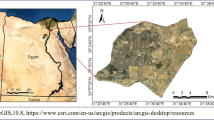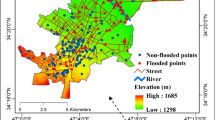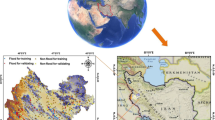Abstract
In this study, a genetic programming (GP) algorithm is introduced to solve the symbolic regression problem for flash flood risk zoning in Beijing. GP operates in simulation of biological revolution and can avoid arbitrariness in risk estimates. Herein, this revolutionary computing searched for an appropriate model to best fit the training samples which comprise the data fields of the predictand of Ripley’s K-values to be the posterior risk, and the predictors of the rainstorm hazard index value (RHIV), physical vulnerability, terrain factor, impervious surface area, and population density. After generations of revolution, the optimal fit regressions for estimating the risk value were determined in the form of function (parse) trees. Also, the grid risk values were calculated using the deduced regression. The risk zoning map indicates that the risk values are higher in urban areas, which is reasonable in comparison with the distribution of historical flash flood events. With an explicit model structure, this symbolic regression manifests that the risk value is mainly determined by the RHIV and impervious land surface and is weakly correlated with the other risk factors, e.g., the physical vulnerability, the terrain factor, and population density. Our research demonstrates that GP in an artificial intelligence manner meets the needs of risk assessment in determining the optimal fit regressions and is a promising technique for future applications. Meanwhile, approaches are still available for improving the GP application in the risk assessment, e.g., considering the historical losses in posterior risk estimations and improvement in the sampling training data.






Similar content being viewed by others
References
Arnold CL, Gibbons CJ (1996) Impervious surface coverage: the emergence of a key environmental indicator. J Am Plan As 62:243–258
Cantet P, Bacro J, Arnaud P (2011) Using a rainfall stochastic generator to detect trends in extreme rainfall. Stoch Environ Res Risk Assess 25:429–441. doi:10.1007/soo477-010-0440-x
Chen J, Li C, Li Z (2001) A Voronoi-based 9-intersection model for spatial relations. Int J Geogr Inf Sci 15(3):201–220
Cook A, Merwade V (2009) Effect of topographic data, geometric configuration and modeling approach on flood inundation mapping. J Hydrol 377:131–142
Degaetano AT (2009) Time-dependent changes in extreme-precipitation return-period amounts in the continental United States. J Appl Meteorol Climatol 48:2086–2099
Downing TE, Butterfield R, Cohen S et al (2001) Vulnerability indices: climate change impacts and adaptation. UNEP Policy Series, UNEP, Nairobi
Dunne T, Black RD (1970) An experimental investigation of runoff production in permeable soils. Water Resour Res 6:478–490
Durkee JD, Campbell L et al (2012) A synoptic perspective of the record 1–2 May 2010 mid-south heavy precipitation event. Bull Am Meteorol Soc 93(5):611–620
Grimm AM (2011) Interannual climate variability in South America: impacts on seasonal precipitation, extreme events, and possible effects of climate change. Stoch Environ Res Risk Assess 25:537–554
Gumrukcuoglu M, Goodin D, Martin C (2010) Landuse change in upper Kansas river floodplain: following the 1993 flood. Nat Hazards 55:467–479. doi:10.1007/s11069-010-9540-7
Guo J, Guo S et al (2012) Spatial and temporal variation of extreme precipitation indices in the Yangtze River basin, China. Stoch Env Res Risk Assess 27(2):459–475. doi:10.1007/s00477-012-0643-4
Hoai NX (2001) Solving The symbolic regression problem with tree-adjunct grammar guided genetic programming: the preliminary results. In: Proceedings of the 5th Autraliasia-Japan co-joint workshop on evolutionary computation, pp 52–61
Holland J (1992) Adaptation in natural and artificial systems: an introductory analysis with applications to biology, control, and artificial intelligence, 2nd edn. MIT Press, Cambridge
Hu H (2014) An algorithm for converting weather radar data into GIS polygons and its application in severe weather warning systems. Int J Geogr Inf Sci 28(9):1665–1780. doi:10.1080/13658816.2014.898767
Hu H, Liang X, You F, Sun J (2015) An analysis of meteorological services under extreme weather conditions based on a Bayesian decision-support model: a case study of the thunderstorms in Beijing on 21 July 2012. Nat Hazards. doi:10.1007/s11069-015-1766-y
Huang C (1997) Two models to assess fuzzy risk of natural disaster in China. J Fuzzy Logic Intell Syst 14(6):141–146
IPCC (2001) Climate change 2001: impacts, adaptation and vulnerability, summary for policymakers. WMO, New York
IPCC (2007) Climate change 2007: synthesis report. In: Pachauri RK, Reisinger A (eds) Contribution of working groups I, II and III to the fourth assessment report of the intergovernmental panel on climate change. WMO, Geneva, p 104
Jongejan RB, Maaskant B (2015) Quantifying flood risks in the Netherlands. Risk Anal 35:252–264. doi:10.1111/risa.12285
Kaplan S, Garrick BJ (1981) On the quantitative definition of risk. Risk Anal 1:11–27
Kim J, Kuwahara Y, Kumar M (2011) A DEM-based evaluation of potential flood risk to enhance decision support system for safe evacuation. Nat Hazards 59:1561–1572. doi:10.1007/s11069-011-9852-2
Kim Y, Seo SB, Jang O (2012) Flood risk assessment using regional regression analysis. Nat Hazards 63:1203–1217. doi:10.1007/s11069-012-0221-6
Koza JR (1990) Concept formation and decision tree induction using the genetic programming paradigm. In: Schwefel HP, Manner R (eds) Parallel problem solving from nature. Springer, Berlin, pp 124–129
Koza JR (1992) Genetic programming: on the programming of computers by means of natural selection. MIT Press, Cambridge
Koza JR (1995) Survey of genetic algorithms and genetic programming. In: Conference: WESCON/’95. Conference record. Microelectronics communications technology producing quality products mobile and portable power emerging technologies. IEEE Press, San Francisco, CA, USA. doi:10.1109/WESCON.1995.485447
Lind N, Pandey M, Nathwani J (2009) Assessing and affording the control of flood risk. Struct Saf 31:143–147
Lu XX, Ran L (2011) China flood havoc highlights poor urban planning. Nat Hazards 56:575–576. doi:10.1007/s11069-011-9720-0
Maqsood I, Huang GH (2012) A dual two-stage stochastic model for flood management with inexact-integer analysis under multiple uncertainties. Stoch Env Res Risk Assess 27(3):643–657. doi:10.1007/s00477-012-0629-2
Mendes B, Pericchi L (2009) Assessing conditional extremal risk of flooding in Puerto Rico. Stoch Environ Res Risk Assess 23:399–410. doi:10.1007/s00477-008-0220-z
Meyer V, Scheuer S, Haase D (2009) A multicriteria approach for flood risk mapping exemplified at the Mulde river, Germany. Nat Hazards 48:17–39. doi:10.1007/s11069-008-9244-4
Ripley BD (1981) Spatial statistics. Wiley, Chichester
Roebber PJ (2013) Using evolutionary programming to generate skillful extreme value probabilistic forecasts. Mon Weather Rev 141:3170–3185. doi:10.1175/MWR-D-12-00285.1
Roston G, Sturges R (1995) A genetic design methodology for structure configuration. ASME Adv Des Autom DE82:73–90
Rucinska D (2015) Spatial distribution of flood risk and quality of spatial management: case study in Odra Valley, Poland. Risk Anal 35:241–251. doi:10.1111/risa.12295
Sanders BF (2007) Evaluation of on-line DEMs for flood inundation modeling. Adv Water Resour 30:1831–1843
Shari HO, Yates D, Roberts R, Muller C (2006) The use of an automated nowcasting system to forecast flash floods in an urban watershed. J Hydrometeorol 7:190–202
Shi J, Cui L (2012) Characteristics of high impact weather and meteorological disaster in Shanghai, China. Nat Hazards 60:951–969. doi:10.1007/s11069-011-9877-6
Shook G (1997) An assessment of disaster risk and its management in Thailand. Disasters 21(1):77–88
Smith K (1996) Environmental hazards: assessing risk and reducing disaster, 2nd edn. Routledge, New York
Solín, Ľ, Feranec J, Nováček J (2011) Land cover changes in small catchments in Slovakia during 1990–2006 and their effects on frequency of flood events. Nat Hazards 56:195–214. doi:10.1007/s11069-010-9562-1
Stevens Mark R, Song Y, Berke P (2010) New Urbanist developments in flood-prone areas: safe development, or safe development paradox? Nat Hazards 53:605–629. doi:10.1007/s11069-009-9450-8
Villarin G, Smith JA et al (2009) Flood frequency analysis for nonstationary annual peak records in an urban drainage basin. Adv Water Resour 32:1255–1266
Whigham PA, Recknagel F (2001) An inductive approach to ecological time series modeling by evolutionary computation. Ecol Model 146:275–287
White AB, Colman B et al (2012) NOAA’s rapid response to the Howard A. Hanson Dam flood risk management crisis. Bull Am Meteorol Soc 93(2):189–207
Yang G, Bowling LC et al (2010) Hydroclimatic response of watersheds to urban intensity: an observational and modeling-based analysis for the White River Basin, Indiana. J Hydrometeorol 11:122–138
Acknowledgments
This study was supported by the National Natural Science Foundation of China (Project: 41175099) and the Beijing Natural Science Foundation of China (Project: 8142019).
Author information
Authors and Affiliations
Corresponding author
Rights and permissions
About this article
Cite this article
Hu, H. Rainstorm flash flood risk assessment using genetic programming: a case study of risk zoning in Beijing. Nat Hazards 83, 485–500 (2016). https://doi.org/10.1007/s11069-016-2325-x
Received:
Accepted:
Published:
Issue Date:
DOI: https://doi.org/10.1007/s11069-016-2325-x




